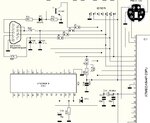neazoi
Advanced Member level 6

In the image attached the Green block is an ATMEGA644 and the blue is a AT45DB081 flash.
They are connected using the ISP of the MCU.
How can I connect a second identical flash to the ISP (and possibly other devices) and being able to select each of them with the use of a jumper switch?
They are connected using the ISP of the MCU.
How can I connect a second identical flash to the ISP (and possibly other devices) and being able to select each of them with the use of a jumper switch?


